+ Open data
Open data
- Basic information
Basic information
| Entry | Database: PDB / ID: 7tea | ||||||
|---|---|---|---|---|---|---|---|
| Title | Crystal structure of S. aureus GlnR-DNA complex | ||||||
 Components Components |
| ||||||
 Keywords Keywords | DNA BINDING PROTEIN/DNA / GlnR / winged-HTH / S. aureus / femC / glutamine synthetase / transcription repressor / DNA BINDING PROTEIN / DNA BINDING PROTEIN-DNA complex | ||||||
| Function / homology |  Function and homology information Function and homology information | ||||||
| Biological species |  | ||||||
| Method |  X-RAY DIFFRACTION / X-RAY DIFFRACTION /  SYNCHROTRON / SYNCHROTRON /  MOLECULAR REPLACEMENT / MOLECULAR REPLACEMENT /  molecular replacement / Resolution: 2.35 Å molecular replacement / Resolution: 2.35 Å | ||||||
 Authors Authors | Schumacher, M.A. | ||||||
| Funding support |  United States, 1items United States, 1items
| ||||||
 Citation Citation |  Journal: Nat Commun / Year: 2022 Journal: Nat Commun / Year: 2022Title: Molecular dissection of the glutamine synthetase-GlnR nitrogen regulatory circuitry in Gram-positive bacteria. Authors: Brady A Travis / Jared V Peck / Raul Salinas / Brandon Dopkins / Nicholas Lent / Viet D Nguyen / Mario J Borgnia / Richard G Brennan / Maria A Schumacher /  Abstract: How bacteria sense and respond to nitrogen levels are central questions in microbial physiology. In Gram-positive bacteria, nitrogen homeostasis is controlled by an operon encoding glutamine ...How bacteria sense and respond to nitrogen levels are central questions in microbial physiology. In Gram-positive bacteria, nitrogen homeostasis is controlled by an operon encoding glutamine synthetase (GS), a dodecameric machine that assimilates ammonium into glutamine, and the GlnR repressor. GlnR detects nitrogen excess indirectly by binding glutamine-feedback-inhibited-GS (FBI-GS), which activates its transcription-repression function. The molecular mechanisms behind this regulatory circuitry, however, are unknown. Here we describe biochemical and structural analyses of GS and FBI-GS-GlnR complexes from pathogenic and non-pathogenic Gram-positive bacteria. The structures show FBI-GS binds the GlnR C-terminal domain within its active-site cavity, juxtaposing two GlnR monomers to form a DNA-binding-competent GlnR dimer. The FBI-GS-GlnR interaction stabilizes the inactive GS conformation. Strikingly, this interaction also favors a remarkable dodecamer to tetradecamer transition in some GS, breaking the paradigm that all bacterial GS are dodecamers. These data thus unveil unique structural mechanisms of transcription and enzymatic regulation. | ||||||
| History |
|
- Structure visualization
Structure visualization
| Structure viewer | Molecule:  Molmil Molmil Jmol/JSmol Jmol/JSmol |
|---|
- Downloads & links
Downloads & links
- Download
Download
| PDBx/mmCIF format |  7tea.cif.gz 7tea.cif.gz | 238.4 KB | Display |  PDBx/mmCIF format PDBx/mmCIF format |
|---|---|---|---|---|
| PDB format |  pdb7tea.ent.gz pdb7tea.ent.gz | 186.5 KB | Display |  PDB format PDB format |
| PDBx/mmJSON format |  7tea.json.gz 7tea.json.gz | Tree view |  PDBx/mmJSON format PDBx/mmJSON format | |
| Others |  Other downloads Other downloads |
-Validation report
| Arichive directory |  https://data.pdbj.org/pub/pdb/validation_reports/te/7tea https://data.pdbj.org/pub/pdb/validation_reports/te/7tea ftp://data.pdbj.org/pub/pdb/validation_reports/te/7tea ftp://data.pdbj.org/pub/pdb/validation_reports/te/7tea | HTTPS FTP |
|---|
-Related structure data
| Related structure data | 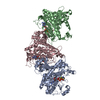 7tdpC  7tdvC  7tecC 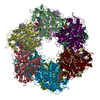 7tenC  7tf6C  7tf7C 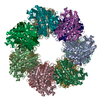 7tf9C 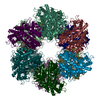 7tfaC  7tfbC 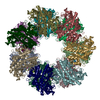 7tfcC  7tfdC  7tfeC  4r4eS S: Starting model for refinement C: citing same article ( |
|---|---|
| Similar structure data | Similarity search - Function & homology  F&H Search F&H Search |
- Links
Links
- Assembly
Assembly
| Deposited unit | 
| |||||||||
|---|---|---|---|---|---|---|---|---|---|---|
| 1 | 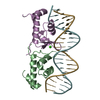
| |||||||||
| 2 | 
| |||||||||
| Unit cell |
| |||||||||
| Components on special symmetry positions |
|
- Components
Components
| #1: Protein | Mass: 10141.709 Da / Num. of mol.: 4 Source method: isolated from a genetically manipulated source Source: (gene. exp.)  Gene: glnR, femC, BN1321_240156, BSG37_06895, BTN44_06150, C7P97_11270, CFN13_06110, CSC87_13065, CV021_11625, DD547_01329, DQU54_07135, E3A28_02075, E3K14_06475, E4U00_04150, E5491_06810, ELP52_ ...Gene: glnR, femC, BN1321_240156, BSG37_06895, BTN44_06150, C7P97_11270, CFN13_06110, CSC87_13065, CV021_11625, DD547_01329, DQU54_07135, E3A28_02075, E3K14_06475, E4U00_04150, E5491_06810, ELP52_06590, FA040_05040, FAF32_003415, FPP26_06465, FVP29_03765, G6X35_05925, G6X37_15500, G6Y24_07775, GO782_03725, GO788_03065, GO793_18140, GO810_03920, GO814_05910, GO941_02620, GO942_07700, GQX37_02050, GZ128_03000, GZ145_02540, HMPREF3211_01353, NCTC10654_01351, NCTC10702_02054, NCTC5664_02143, NCTC6133_01601, RK64_06965, SA0759_02803, SA950122_02714, SAGV51_01473, SAGV69_01244, SAHC1335_02241, SAJPND4_01239, SAMEA1029536_01443, SAMEA103891420_00579, SAMEA103891454_00903, SAMEA2076468_01609, SAMEA2076503_01121, SAMEA2077334_01678, SAMEA2078260_01440, SAMEA2078588_01695, SAMEA2079501_01495, SAMEA2080344_01609, SAMEA2081063_01288, SAMEA4008569_01468, SAMEA70146418_02626, SAMEA70245418_01181 Production host:  #2: DNA chain | Mass: 6447.185 Da / Num. of mol.: 2 / Source method: obtained synthetically / Details: synthetic GlnR operator DNA / Source: (synth.)  #3: DNA chain | Mass: 6438.171 Da / Num. of mol.: 2 / Source method: obtained synthetically / Source: (synth.)  #4: Chemical | #5: Water | ChemComp-HOH / | Has ligand of interest | Y | |
|---|
-Experimental details
-Experiment
| Experiment | Method:  X-RAY DIFFRACTION / Number of used crystals: 1 X-RAY DIFFRACTION / Number of used crystals: 1 |
|---|
- Sample preparation
Sample preparation
| Crystal | Density Matthews: 2.97 Å3/Da / Density % sol: 58.61 % |
|---|---|
| Crystal grow | Temperature: 275 K / Method: vapor diffusion, hanging drop Details: 50 mM sodium cacodylate pH 6.5, 13% PEG 8000, 0.15 M calcium acetate, 20% glycerol |
-Data collection
| Diffraction | Mean temperature: 100 K / Serial crystal experiment: N | |||||||||||||||||||||
|---|---|---|---|---|---|---|---|---|---|---|---|---|---|---|---|---|---|---|---|---|---|---|
| Diffraction source | Source:  SYNCHROTRON / Site: SYNCHROTRON / Site:  ALS ALS  / Beamline: 5.0.2 / Wavelength: 1.09 Å / Beamline: 5.0.2 / Wavelength: 1.09 Å | |||||||||||||||||||||
| Detector | Type: DECTRIS PILATUS 6M / Detector: PIXEL / Date: Mar 1, 2021 | |||||||||||||||||||||
| Radiation | Protocol: SINGLE WAVELENGTH / Monochromatic (M) / Laue (L): M / Scattering type: x-ray | |||||||||||||||||||||
| Radiation wavelength | Wavelength: 1.09 Å / Relative weight: 1 | |||||||||||||||||||||
| Reflection | Resolution: 2.35→49.63 Å / Num. obs: 31531 / % possible obs: 98.6 % / Redundancy: 6.2 % / CC1/2: 1 / Rpim(I) all: 0.027 / Rsym value: 0.042 / Net I/σ(I): 21.4 | |||||||||||||||||||||
| Reflection shell | Diffraction-ID: 1
|
-Phasing
| Phasing | Method:  molecular replacement molecular replacement |
|---|
- Processing
Processing
| Software |
| |||||||||||||||||||||||||||||||||||||||||||||||||||||||||||||||||||||||||||||||||||||||||||||||||||||||||
|---|---|---|---|---|---|---|---|---|---|---|---|---|---|---|---|---|---|---|---|---|---|---|---|---|---|---|---|---|---|---|---|---|---|---|---|---|---|---|---|---|---|---|---|---|---|---|---|---|---|---|---|---|---|---|---|---|---|---|---|---|---|---|---|---|---|---|---|---|---|---|---|---|---|---|---|---|---|---|---|---|---|---|---|---|---|---|---|---|---|---|---|---|---|---|---|---|---|---|---|---|---|---|---|---|---|---|
| Refinement | Method to determine structure:  MOLECULAR REPLACEMENT MOLECULAR REPLACEMENTStarting model: 4R4E Resolution: 2.35→49.63 Å / SU ML: 0.47 / Cross valid method: THROUGHOUT / σ(F): 0 / Phase error: 38.36 / Stereochemistry target values: ML
| |||||||||||||||||||||||||||||||||||||||||||||||||||||||||||||||||||||||||||||||||||||||||||||||||||||||||
| Solvent computation | Shrinkage radii: 0.9 Å / VDW probe radii: 1.11 Å / Solvent model: FLAT BULK SOLVENT MODEL | |||||||||||||||||||||||||||||||||||||||||||||||||||||||||||||||||||||||||||||||||||||||||||||||||||||||||
| Displacement parameters | Biso max: 165.69 Å2 / Biso mean: 73.7533 Å2 / Biso min: 30 Å2 | |||||||||||||||||||||||||||||||||||||||||||||||||||||||||||||||||||||||||||||||||||||||||||||||||||||||||
| Refinement step | Cycle: final / Resolution: 2.35→49.63 Å
| |||||||||||||||||||||||||||||||||||||||||||||||||||||||||||||||||||||||||||||||||||||||||||||||||||||||||
| Refine LS restraints |
| |||||||||||||||||||||||||||||||||||||||||||||||||||||||||||||||||||||||||||||||||||||||||||||||||||||||||
| LS refinement shell | Refine-ID: X-RAY DIFFRACTION / Rfactor Rfree error: 0 / Total num. of bins used: 14
| |||||||||||||||||||||||||||||||||||||||||||||||||||||||||||||||||||||||||||||||||||||||||||||||||||||||||
| Refinement TLS params. | Method: refined / Origin x: 41.7984 Å / Origin y: 61.1108 Å / Origin z: 91.5599 Å
| |||||||||||||||||||||||||||||||||||||||||||||||||||||||||||||||||||||||||||||||||||||||||||||||||||||||||
| Refinement TLS group |
|
 Movie
Movie Controller
Controller











 PDBj
PDBj











































